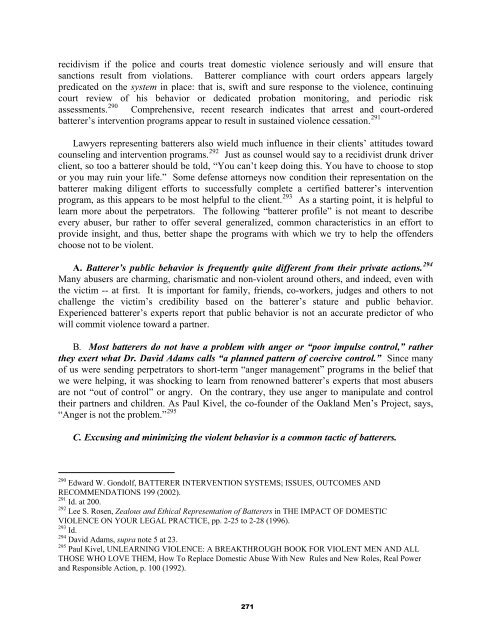A Judge’s Guide
A Judge’s Guide
A Judge’s Guide
You also want an ePaper? Increase the reach of your titles
YUMPU automatically turns print PDFs into web optimized ePapers that Google loves.
ecidivism if the police and courts treat domestic violence seriously and will ensure that<br />
sanctions result from violations. Batterer compliance with court orders appears largely<br />
predicated on the system in place: that is, swift and sure response to the violence, continuing<br />
court review of his behavior or dedicated probation monitoring, and periodic risk<br />
assessments. 290 Comprehensive, recent research indicates that arrest and court-ordered<br />
batterer’s intervention programs appear to result in sustained violence cessation. 291<br />
Lawyers representing batterers also wield much influence in their clients’ attitudes toward<br />
counseling and intervention programs. 292 Just as counsel would say to a recidivist drunk driver<br />
client, so too a batterer should be told, “You can’t keep doing this. You have to choose to stop<br />
or you may ruin your life.” Some defense attorneys now condition their representation on the<br />
batterer making diligent efforts to successfully complete a certified batterer’s intervention<br />
program, as this appears to be most helpful to the client. 293 As a starting point, it is helpful to<br />
learn more about the perpetrators. The following “batterer profile” is not meant to describe<br />
every abuser, bur rather to offer several generalized, common characteristics in an effort to<br />
provide insight, and thus, better shape the programs with which we try to help the offenders<br />
choose not to be violent.<br />
A. Batterer’s public behavior is frequently quite different from their private actions. 294<br />
Many abusers are charming, charismatic and non-violent around others, and indeed, even with<br />
the victim -- at first. It is important for family, friends, co-workers, judges and others to not<br />
challenge the victim’s credibility based on the batterer’s stature and public behavior.<br />
Experienced batterer’s experts report that public behavior is not an accurate predictor of who<br />
will commit violence toward a partner.<br />
B. Most batterers do not have a problem with anger or “poor impulse control,” rather<br />
they exert what Dr. David Adams calls “a planned pattern of coercive control.” Since many<br />
of us were sending perpetrators to short-term “anger management” programs in the belief that<br />
we were helping, it was shocking to learn from renowned batterer’s experts that most abusers<br />
are not “out of control” or angry. On the contrary, they use anger to manipulate and control<br />
their partners and children. As Paul Kivel, the co-founder of the Oakland Men’s Project, says,<br />
“Anger is not the problem.” 295<br />
C. Excusing and minimizing the violent behavior is a common tactic of batterers.<br />
290<br />
Edward W. Gondolf, BATTERER INTERVENTION SYSTEMS; ISSUES, OUTCOMES AND<br />
RECOMMENDATIONS 199 (2002).<br />
291<br />
Id. at 200.<br />
292<br />
Lee S. Rosen, Zealous and Ethical Representation of Batterers in THE IMPACT OF DOMESTIC<br />
VIOLENCE ON YOUR LEGAL PRACTICE, pp. 2-25 to 2-28 (1996).<br />
293<br />
Id.<br />
294<br />
David Adams, supra note 5 at 23.<br />
295<br />
Paul Kivel, UNLEARNING VIOLENCE: A BREAKTHROUGH BOOK FOR VIOLENT MEN AND ALL<br />
THOSE WHO LOVE THEM, How To Replace Domestic Abuse With New Rules and New Roles, Real Power<br />
and Responsible Action, p. 100 (1992).<br />
271


